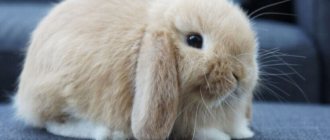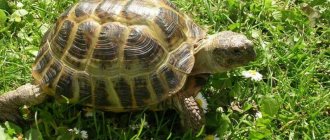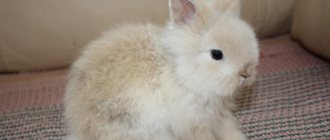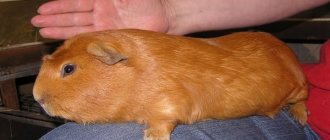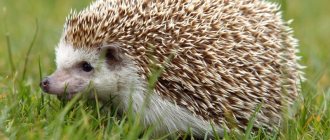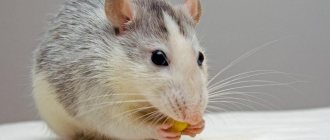Review author: “ZooVita”
The dwarf fold ram is the most popular breed of decorative rabbits. A cute animal with a charming face, cute floppy ears and a calm character, it is most suitable for children and beginners.
From the outside, a rabbit may seem like a toy, but it is a living creature that requires attention, care, and responsibility from its owner. In return, the handsome furry man is able to give love, devoted friendship, and a lot of pleasant emotions.
Before purchasing an animal, you need to study its habits, behavior, know what to feed a dwarf rabbit, and how to care for it.
History of the breed
Unusual lop-eared rabbits look very similar to small lambs. For the first time, C. Darwin spoke about them, who noticed in the litter of ordinary animals with erect ears, fold-eared babies. This phenomenon has interested breeders.
Already by the middle of the 20th century, breeders from Holland developed a new breed by crossing small decorative rabbits with French Folds.
Since 1964, the breed has been officially recognized. Dwarf rams appeared in Russia in the late 90s and immediately won the hearts of pet lovers.
Reasons for a mother rabbit's refusal to feed her babies
After giving birth, females are not always ready to take care of the offspring. Due to inexperience or health problems, some refuse to feed their cubs. Caring for newborn rabbits includes daily inspection of the nest. Farmers check whether the babies are fed. A sign of satiety is full tummies and the absence of folds on the body of the rabbits .
Attention! If the female does not feed the cubs, they crawl through the queen cell in search of milk.
The reasons for a female rabbit’s refusal to feed her offspring are different:
- changes in hormonal levels (the female is in heat);
- mastitis;
- lack of milk;
- inexperience;
- stress after childbirth.
Peculiarities
A distinctive feature of the dwarf ram is its thick, drooping ears. Their size varies from 25-30 to 65-70 cm. They are rounded at the ends and resemble a horseshoe.
A baby rabbit 45 days old weighs 0.45-0.5 kg, an adult dwarf lop-eared rabbit - 30-35 cm weighs 1.6-2.2 kg.
The animals have a large head, a powerful back of the head, a large forehead, and eyes like almonds.
The cylinder-shaped body is covered with soft, shiny fur, similar to silk. The villi are short, medium and long. Color, pattern, markings, and undercoat indicate a representative of a certain breed.
The character is calm, balanced, the animals are patient and easy to make contact with.
Lion head
Another amazing subspecies of the lion breed. The long-haired variety was developed in Belgium. The length of the coat can reach a record 7 cm.
They have strong legs. The chest is rounded, and the proportional body is oval in shape. The round head has protruding round ears. This species is distinguished by its unusual, peculiar hairstyle made of long wool.
Among lovers, rabbits with an opal color, as well as chinchilla and orange ones, are considered valuable. They have a calm disposition, easily get used to the house, and love children. One thing. This breed is very shy, and therefore you need to play with them very carefully.
A few more photos...
To complete the picture, let’s present a few more photographs of these wonderful animals. There are entire groups of rabbit lovers on the Internet who post funny photos and videos of cute creatures.
?
Varieties
Breeders all over the world tried to create their own animal with floppy ears, which is why there were so many breeds. Among them there are both dwarf and rather large specimens.
Please note ⭐⭐⭐
Degu (Chilean squirrel): photo and description, keeping at home, how long they live
Marmots (Marmota): interesting facts, habitat, what it looks like, color, size, photos, types
Domestic chinchilla: recommendations for keeping it at home, types, color, character, how to feed and care (150 photos)
Care
Keeping a dwarf rabbit at home requires a caring and responsible attitude.
The optimal room temperature is from 16°C to 23°C. The sun's rays falling on the animal can lead to heat stroke.
The cages must be clean and spacious. The tray, drinking bowl and feeder are washed every day, the bedding is changed 4 times a month. It is highly undesirable to use plastic cages as they emit harmful substances. It is better to treat wooden specimens so that the pet does not get hurt.
Problem areas and dirty fur are wiped with a damp cloth, then wiped dry, long nails are trimmed.
How to feed newborns yourself
The rabbits left by their mother are kept in a separate box. They put a bottle of hot water there, wrapped in a towel, and lay the babies on it. This way they won't be able to detect the substitution. In the future, the usual insulation for the cage will be enough for them.
It is important for babies to have a feeding schedule that matches their natural rhythms. And they usually eat between 2 and 6 am. They must not be allowed to remain hungry at this time. If the owner placed the “foster” rabbit in the cage with the babies at this time, and she did not feed them, he will have to feed the offspring himself. But regular cow's milk should not be given to babies. Experts advise mixing a glass of milk with raw chicken yolk, a small amount of molasses and two drops of vitamins, which in this case should be in liquid form, since they are better absorbed this way.
Newborns require very careful handling, they are so small and fragile, they even need to be handled carefully so as not to suffocate or accidentally crush them.
Ideally, baby rabbits should be fed in such a way that the procedure resembles natural sucking. The food is poured into a medicine bottle (just so that it has no odor), and a cotton swab is inserted into it so that the mixture gradually seeps through the cotton wool. The rabbits themselves know how much they need.
It is already easier to feed two-month-old rabbits - you can do this with a syringe without a needle or pipette, and then gradually introduce green food. If it happens in the summer, then it is best to choose chamomile and plantain. But you also need to continue to monitor your health. If the owner notices signs of diarrhea, then complementary foods should be removed and only breast milk substitute should be left. What rabbits should absolutely not be given is food from the human table. Baking, pasta, and sweets are very harmful to the body of young children, and they will not bring any benefit in adulthood.
When the feeding procedure is completed, the babies' faces will need to be carefully wiped with napkins so that no food particles remain on them. Its particles can clog the respiratory system and get into the eyes. So, according to hygienic requirements, the muzzle is wiped with a damp towel.
The same is done with the genitals of the animal. Here you need even more caution - the rabbits’ bodies are still very tender. You need to make sure that kids go to the toilet on time. To make a baby rabbit urinate, you need to lightly press on its tummy. These are natural actions, they repeat what the mother rabbit does every day. This is necessary in order to push out everything stuck in the intestines. If this is not done, then even death is possible.
Reproduction
The pregnancy of a female dwarf breed lasts from 29 to 32 days. In one litter she brings from 3 to 7 rabbits. When the babies are 2 weeks old, they begin to climb out of the nest on their own. The young are separated from their mother at the age of two months.
Newborns require special care. They must be protected from direct sunlight, wind, dust, and high humidity.
Contents of baby rabbits
The process of giving birth to baby rabbits is common even for small farms. The female nurses the offspring for several months and provides food for the small rodents. All the time that the rabbits spend in the cage in the nests, the farmer takes care of their mother. In the enclosure of a new furry mother there should always be clean water and food rich in vitamins and nutrients. You should not contact the brood, which is hiding in nests. A common reason for a female to abandon her own offspring is human intervention.
Rabbits are born completely blind and deaf. The feelings through which baby rabbits learn about the world around them appear gradually. At the age of the first few days, the eyes of the furry rodents open; over time, the rabbits begin to crawl out of the nests. Baby rabbits have little strength in the first weeks of life, and the rodents' diet consists only of rabbit milk. A balanced diet for the new furry mother is the key to the health of the entire brood.
The video “how baby rabbits grow” will help the novice farmer learn about all the important stages of development of domesticated rodents.
After birth, furry animals (rabbits from the same mother) sit in the nest for a week. Gradually, the first hair appears on the animal’s body. It is in the first weeks that the quality of fur is formed, for which adult rabbits are valued. The immune system of an adult rodent depends on the nutrition and care of rodents during this period. For baby rabbits, the mother is the only connection with the outside world, so abandoned litters in most cases die.
The death of a litter is a big loss for a novice rabbit breeder and an experienced farmer. Newborn rabbits have weak immunity, and without feeding on mother's milk, their growth slows down significantly. Until breeding, the rabbits depend on their mother. If in winter or summer the female does not eat well, after the birth of the young she has to be fed with useful supplements. Without proper care, rabbits cannot withstand seasonal diseases or epidemics.
If the rabbits are abandoned, their mother becomes aggressive and must be separated from small rodents. If a new mother has scattered her rabbits around the cage, it is almost impossible to save the brood. Loose stools in small rodents, malaise and weakness are the first symptoms of a disease that is widespread. It is important for a farmer to provide his pets with proper care, otherwise the time and effort spent will not pay off.
Lifespan
Representatives of dwarf breeds live mainly 5-7 years. If you take good care of them, this period can reach 10-12 years. Important:
- do not create stressful situations;
- you cannot shout or make sudden movements that may scare the rabbit;
- when traveling, use a special bag;
- carry out vaccinations;
- high-quality nutritious food.
When purchasing, you should pay attention to affectionate breeds so that the animal quickly gets used to humans. The child must understand that one should not hurt living beings, that one must treat them with care.
Artificial feeding of abandoned offspring
How long should abandoned offspring be cared for? It is necessary to separate the female from the young only in extreme cases; if milk does not appear within 1 day or several days, the farmer purchases a mixture: milk powder, which is prepared at home. Video instructions will help you prepare the mixture correctly and save young animals from starvation within just one day.
The mixture for feeding small rodents consists of:
- a quarter liter of milk;
- one chicken yolk (medium-sized egg);
- one teaspoon of molasses;
- liquid vitamins (1-2 drops).
In 2-3 days, rabbits manage to adapt to the new diet. Artificially fed young animals in the future bring a lot of profit for the entire farm. If rodents cannot switch to a new diet during the day, it will not be possible to avoid the death of the brood. For small furry animals, leaving their mother is a big stress.
Every day, rodents depend on the farmer who breeds them for food, water, and care. Young animals that are left behind should be fed carefully. Small meals every 4 hours will help rodents survive and not choke on food. Removing abandoned animals is not easy, because such a task is a test for a novice farmer.
